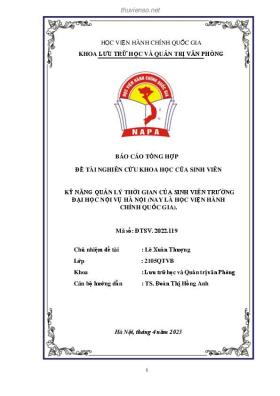
Embedded system design and code generation by using the dsl and T4
Số trang: 10
Loại file: pdf
Dung lượng: 1.20 MB
Lượt xem: 8
Lượt tải: 0
Xem trước 2 trang đầu tiên của tài liệu này:
Thông tin tài liệu:
In the development trend of embedded technology, the methods of embedded system design are studied and widely utilized. This paper presents a new approach to design embedded system and generate code from models based on Domain Specific Language and Text Template Transformation Toolkit.
Nội dung trích xuất từ tài liệu:
Embedded system design and code generation by using the dsl and T4Journal of Computer Science and Cybernetics, V.28, N.4 (2012), 323332EMBEDDED SYSTEM DESIGN AND CODE GENERATIONBY USING THE DSL AND T4∗rew ex r yxqD xq ix xqyg fsxrUniversity of Engineering and Technology Vietnam National University, Hanoi, Vietnam;Email: huongpv@gmail.comTóm t t. rong xu h÷îng ph¡t triºn m¤nh m³ õ æng ngh» nhóngD ¡ ph÷ìng ph¡p thi¸t k¸ h»thèng nhóng ông 1÷ñ nghi¶n ùu v triºn khi rëng r¢iF fi ¡o ny tr¼nh y ¡h ti¸p ªn mîi1º thi¸t k¸ v sinh m¢ ho h» thèng nhóng dü tr¶n ngæn ngú mi·n x¡ 1ành v æng ngh» sinh m¢RF ghóng tæi 1ành ngh¾ ngæn ngú mi·n x¡ 1ànhD x¥y düng si¶u mæ h¼nh t÷ìng ùng v ph¡ttriºn æng ö 1º thi¸t k¸ mæ h¼nh ki¸n tróD mæ h¼nh thnh ph¦n õ h» thèng nhóng v mæ h¼nhho¤t 1ëng õ ¡ thnh ph¦n ph¦n m·m trong h» thèng nhóngF ø mæ h¼nh thi¸t k¸D dü tr¶n ængngh» sinh m¢ R 1º sinh m¢ theo ¡ ngæn ngú kh¡ nhuFAbstract. sn the development trend of emedded tehnologyD the methods of emedded systemdesign re studied nd widely utilizedF his pper presents new pproh to design emeddedsystem nd generte ode from models sed on homin peifi vnguge nd ext emplternsformtion oolkitF e define three homin peifi vngugesD uild the orresponding metEmodels nd develop our frmeworkF he frmework is to design the models of emedded system suhs the rhiteturl model nd the omponent modelF st is lso to design the flow hrt of emeddedsoftwreF fsed on the designed modelsD we pply the ext emplte rnsformtion oolkit togenerte ode from models utomtillyFKeywords. hesign imedded ystemD imedded oftwreD hv @homin peifi vngugeAD godeqenertionD R @ext emplte rnsformtion oolkitAD og @ystem on ghipA1.INTRODUCTIONNowadays, embedded systems technology have strongly developed and the embedded system design plays an important role in the embedded system development. A few authors haveimproved UML 2.0 to support on designing the embedded system [11, 13]. However, UML 2.0has the following limitations:• Each research group develops a concrete UML 2.0 profile. There is not still a generalnormalization of UML for embedded system.• UML tools store the model file in the different formats so it is not portable among theseUML tools.∗ This research is partly supported by a VNU scientific project (group A) for 2012-2013324PHAM VAN HUONG, NGUYEN NGOC BINH• There is not a general normalization for generating the code from model. Each UMLtool has a concrete code generation method.• UML is a multi-purpose language so it is not complete to specify detail information ofembedded systems.In order to solve this problem, we propose an approach to design models of the embeddedsystems and automatically generate code from the models based on DSL and T4. In recentyears, because XML is applied widely for storing the model file and meta-model file, DSL andT4 have developed quickly. T4 code generation technology based on XML allows generatingthe code. The different languages can format generated code. DSL and T4 are prospect trendsdeployed in many fields [1, 8]. Figure 1 [9] shows comparison of the software development costbetween the conventional methodology and the DSL methodology. In this paper, we definethree DSLs to design the architectural model, the component model and the flow chart. Thenwe build the framework that contains these defined DSLs. After that, we also integrate T4templates of the framework to generate parameters and code from the models automatically.The paper is organized as follows: Section 2 Related work; Section 3 Defining the DSLsand developing the framework used to design the models of embedded system; Section 4 Presenting experiments; Section 5 Conclusion and future work.Figure 1. The comparison on the software development cost2.RELATED WORKIn paper [2, 4], there are some UML 2.0 tools which are developed to model embeddedsystem. For example, SYSML tool regards to embedded systems and SoCs particularities,there are quite similarities between the methods used in the area of System Engineering andcomplex SoC design, such as the need for precise requirements management, heterogeneoussystem specification and simulation [5, 8]. One of the major contributions of SYSML in the areaof embedded system and SoCs is the support for requirements of modeling. We have studiedthe other tool that is UML-SOC [7, 12]. The profile of this tool intends to describe SoCs usingthe UML. UML-SOC focuses on the structural diagrams. It proposed the stereotypes thatallow the structural modeling, communication modeling, operation and property modeling.Although there is some UML 2.0 tools but these tools have separated UML profiles and theyalso support to design the different kinds of model. Moreover, most of UML tools do notsupport optimal techniques at the model level.There are also some studied using the DSL to design model of the embedded system now[3]. For example, the paper [8] defined DSL and developed the framework to specify and designEMBEDDED SYSTEM DESIGN AND CODE GENERATION BY USING THE DSL AND T4325real time embedded system. In the paper [1], the authors also studied and developed the DSLto co-design hardware and software for FPGA. Based on these results, we propose a newapproach to embedded system design using DSL presented in the next sections.Figure 2. The design process of embedded system3.DEFINING THE DSLS AND DEVELOPING THE FRAMEWORKIn this paper, we apply the design process of embedded system as shown in Figure 2.First, we define a DSL to design the architectural model of the embedded system. From thearchitectural model, we use T4 to generate parameters, which are to have multi-objectiveoptimization for embedded systems on other our research. Second, in order to design detail ...
Nội dung trích xuất từ tài liệu:
Embedded system design and code generation by using the dsl and T4Journal of Computer Science and Cybernetics, V.28, N.4 (2012), 323332EMBEDDED SYSTEM DESIGN AND CODE GENERATIONBY USING THE DSL AND T4∗rew ex r yxqD xq ix xqyg fsxrUniversity of Engineering and Technology Vietnam National University, Hanoi, Vietnam;Email: huongpv@gmail.comTóm t t. rong xu h÷îng ph¡t triºn m¤nh m³ õ æng ngh» nhóngD ¡ ph÷ìng ph¡p thi¸t k¸ h»thèng nhóng ông 1÷ñ nghi¶n ùu v triºn khi rëng r¢iF fi ¡o ny tr¼nh y ¡h ti¸p ªn mîi1º thi¸t k¸ v sinh m¢ ho h» thèng nhóng dü tr¶n ngæn ngú mi·n x¡ 1ành v æng ngh» sinh m¢RF ghóng tæi 1ành ngh¾ ngæn ngú mi·n x¡ 1ànhD x¥y düng si¶u mæ h¼nh t÷ìng ùng v ph¡ttriºn æng ö 1º thi¸t k¸ mæ h¼nh ki¸n tróD mæ h¼nh thnh ph¦n õ h» thèng nhóng v mæ h¼nhho¤t 1ëng õ ¡ thnh ph¦n ph¦n m·m trong h» thèng nhóngF ø mæ h¼nh thi¸t k¸D dü tr¶n ængngh» sinh m¢ R 1º sinh m¢ theo ¡ ngæn ngú kh¡ nhuFAbstract. sn the development trend of emedded tehnologyD the methods of emedded systemdesign re studied nd widely utilizedF his pper presents new pproh to design emeddedsystem nd generte ode from models sed on homin peifi vnguge nd ext emplternsformtion oolkitF e define three homin peifi vngugesD uild the orresponding metEmodels nd develop our frmeworkF he frmework is to design the models of emedded system suhs the rhiteturl model nd the omponent modelF st is lso to design the flow hrt of emeddedsoftwreF fsed on the designed modelsD we pply the ext emplte rnsformtion oolkit togenerte ode from models utomtillyFKeywords. hesign imedded ystemD imedded oftwreD hv @homin peifi vngugeAD godeqenertionD R @ext emplte rnsformtion oolkitAD og @ystem on ghipA1.INTRODUCTIONNowadays, embedded systems technology have strongly developed and the embedded system design plays an important role in the embedded system development. A few authors haveimproved UML 2.0 to support on designing the embedded system [11, 13]. However, UML 2.0has the following limitations:• Each research group develops a concrete UML 2.0 profile. There is not still a generalnormalization of UML for embedded system.• UML tools store the model file in the different formats so it is not portable among theseUML tools.∗ This research is partly supported by a VNU scientific project (group A) for 2012-2013324PHAM VAN HUONG, NGUYEN NGOC BINH• There is not a general normalization for generating the code from model. Each UMLtool has a concrete code generation method.• UML is a multi-purpose language so it is not complete to specify detail information ofembedded systems.In order to solve this problem, we propose an approach to design models of the embeddedsystems and automatically generate code from the models based on DSL and T4. In recentyears, because XML is applied widely for storing the model file and meta-model file, DSL andT4 have developed quickly. T4 code generation technology based on XML allows generatingthe code. The different languages can format generated code. DSL and T4 are prospect trendsdeployed in many fields [1, 8]. Figure 1 [9] shows comparison of the software development costbetween the conventional methodology and the DSL methodology. In this paper, we definethree DSLs to design the architectural model, the component model and the flow chart. Thenwe build the framework that contains these defined DSLs. After that, we also integrate T4templates of the framework to generate parameters and code from the models automatically.The paper is organized as follows: Section 2 Related work; Section 3 Defining the DSLsand developing the framework used to design the models of embedded system; Section 4 Presenting experiments; Section 5 Conclusion and future work.Figure 1. The comparison on the software development cost2.RELATED WORKIn paper [2, 4], there are some UML 2.0 tools which are developed to model embeddedsystem. For example, SYSML tool regards to embedded systems and SoCs particularities,there are quite similarities between the methods used in the area of System Engineering andcomplex SoC design, such as the need for precise requirements management, heterogeneoussystem specification and simulation [5, 8]. One of the major contributions of SYSML in the areaof embedded system and SoCs is the support for requirements of modeling. We have studiedthe other tool that is UML-SOC [7, 12]. The profile of this tool intends to describe SoCs usingthe UML. UML-SOC focuses on the structural diagrams. It proposed the stereotypes thatallow the structural modeling, communication modeling, operation and property modeling.Although there is some UML 2.0 tools but these tools have separated UML profiles and theyalso support to design the different kinds of model. Moreover, most of UML tools do notsupport optimal techniques at the model level.There are also some studied using the DSL to design model of the embedded system now[3]. For example, the paper [8] defined DSL and developed the framework to specify and designEMBEDDED SYSTEM DESIGN AND CODE GENERATION BY USING THE DSL AND T4325real time embedded system. In the paper [1], the authors also studied and developed the DSLto co-design hardware and software for FPGA. Based on these results, we propose a newapproach to embedded system design using DSL presented in the next sections.Figure 2. The design process of embedded system3.DEFINING THE DSLS AND DEVELOPING THE FRAMEWORKIn this paper, we apply the design process of embedded system as shown in Figure 2.First, we define a DSL to design the architectural model of the embedded system. From thearchitectural model, we use T4 to generate parameters, which are to have multi-objectiveoptimization for embedded systems on other our research. Second, in order to design detail ...
Tìm kiếm theo từ khóa liên quan:
Tạp chí tin học Điều khiển học Embedded system design using the DSL and T4 Code generation Công nghệ nhúngGợi ý tài liệu liên quan:
-
Tóm tắt về giảm bậc cho các mô hình: một giải pháp mang tính bình phẩm.
14 trang 465 0 0 -
Thuật toán bầy ong giải bài toán cây khung với chi phí định tuyến nhỏ nhất
12 trang 32 0 0 -
Lý thuyết mạng hàng đợi và ứng dụng trong các hệ thống truyền tin.
5 trang 30 0 0 -
Bài giảng Hệ thống điều khiển thông minh: Chương 5 - TS. Huỳnh Thái Hoàng
61 trang 28 0 0 -
Cực tiểu hóa thời gian trễ trung bình trong một mạng hàng đợi bằng giải thuật di truyền.
6 trang 28 0 0 -
Xác định hematocrit sử dụng mạng neural được huấn luyện online dựa trên máy học cực độ
8 trang 27 0 0 -
Mô hình cơ sở dữ liệu hướng đối tượng mờ dựa trên ngữ nghĩa địa số gia tử
13 trang 26 0 0 -
Phân tích tính hội tụ của thuật toán di truyền lai mới
8 trang 26 0 0 -
Bài toán lập lịch trong các trường đại học và thuật toán Tabu.
9 trang 24 0 0 -
Phương pháp chia miền giải bài toán biên hỗn hợp mạnh.
12 trang 24 0 0

















